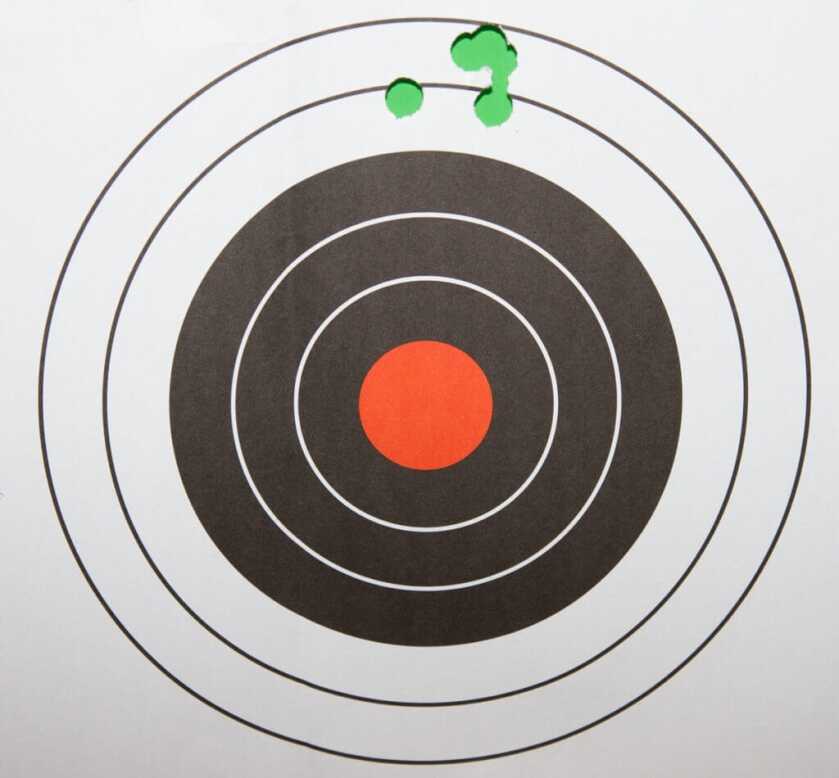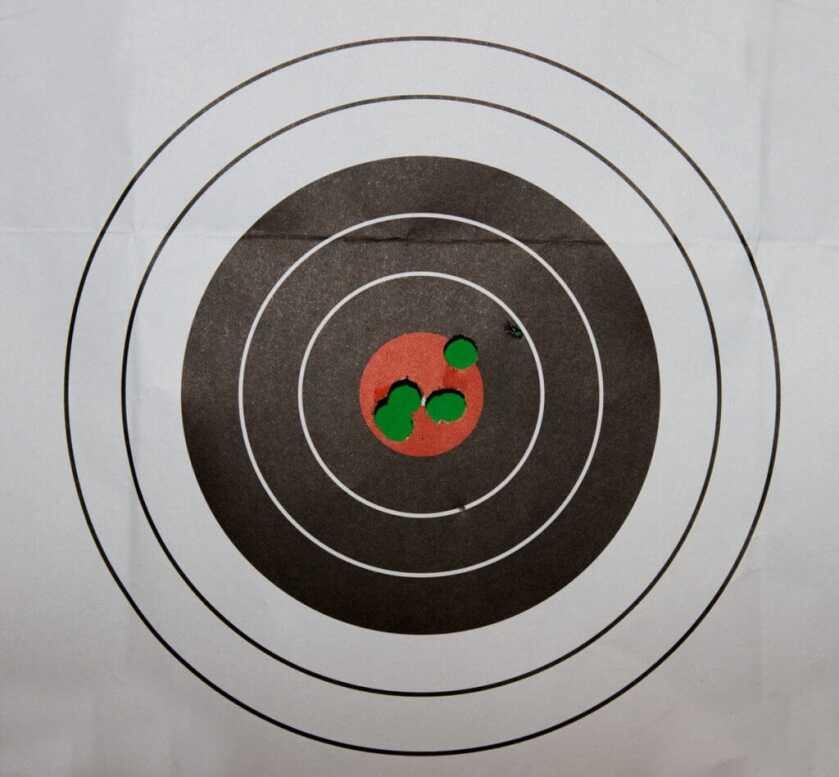YOU MIGHT BE WASTING MONEY ON HANDGUN OR RIFLE ACCURACY
It seems these days there is more interest in accurate guns than there has ever been before. Long distance shooting contests and learning the skills needed to hit targets regularly at distances over 500 yards away has captured the attention of many. Even people who have never fired a gun before are getting interested in the sport. And nearly every handgun review discusses accuracy.
While accuracy and precision in a handgun or rifle are important, just how important are they? For most shooting, they aren’t as important as some people seem to think. It all depends on what the shooter plans to do with the gun.
First, we need to define what we are talking about before discussing how accurate is accurate enough. In the gun world, most people toss around the term accuracy pretty liberally. When they say that, they generally are referring to how well the gun shoots small groups. So what they really mean instead of accuracy is precision.
Most dictionaries use the words accuracy and precision interchangeably. But people who work with numbers, like mathematicians, scientists, and engineers, know the difference. And it’s important when discussing the ability of a gun to shoot small groups.
Accuracy refers to how close the bullet strikes to where the gun is aimed. If the gun is aimed at the center of the bullseye but the bullet strikes three feet away from it, the gun is not accurate. But if that same gun is capable of placing all the bullets near where the first bullet strikes, even if it is three feet away from the bullseye, then the gun is precise. So accuracy refers to the ability of the gun to hit what is aimed at. Precision refers to repeatability or how small the group is, even if it is far away from the point of aim (POA).

So if the shooter wants a gun that prints small groups at the POA, then the gun needs to be both accurate and precise. And since most guns have adjustable sights that allow the POA to be moved to the point of impact (POI), the shooter can get what he wants and the gun is said to be both accurate and precise. Repeatability, or hitting the same place or nearly the same place, every time the gun is fired at a particular target, is often the goal. That’s especially so in bench-rest or long-range competitions.

So if the gun is accurate, i.e., all shots hit close to where the gun is aimed and the sights can be adjusted, then just how precise does the gun have to be? Like so many things, it depends. The late Pat Rogers, a retired New York City Police officer, Marine, and superb trainer of professionals and regular civilians, used to say that the mission drives the gear train. In other words, first decide what needs to be done and then select the tools to do it. In the case of guns, decide first how tight the groups need to be – precision – then select a gun that will accomplish the job.

Let’s look at that. It’s very important and applies to just about everything. If you need to hit a small target without fail, every time, at long distances, then you need an accurate and precise rifle. If you need to hit a large target at moderate ranges, then you need a gun capable of hitting that large area, but precision is not as important.

There are many variables involved in hitting a target at long distances. They include the gun, the ammunition, the shooter, the rest, wind, range to target, temperature, air pressure, humidity, and maybe other things. But we are concentrating on the gun here. So we will stick to discussing the inherent accuracy and precision of the gun and leave out the other variables that have nothing to do with the gun itself.
If the target is likely to be small and far away, then precision and accuracy are very important. If the shooter is a law enforcement sniper and may need to make a head shot to prevent a criminal from detonating a bomb or pulling the trigger of a gun pointed at the head of a hostage, the sniper’s gun needs to be capable of both precision, i.e., shooting small groups, and accuracy, i.e., hitting where the gun is aimed. The sniper may decide his goal is to always hit within one inch of the POA at 100 yards. In that case, both accuracy and precision are critical. The same logic applies if the shooter is using the gun for competition where a fraction of an inch in group size can mean the difference between winning and losing.

If, on the other hand, the target is a man and the shooter is a soldier engaged in battle, with ranges being most often spitting distance to 400 yards, give or take, then accuracy is important, but precision is less so. The soldier may need to, at the minimum, severely wound the enemy so he can no longer fight, which generally (but not always) requires a solid hit to the torso. In that case, a gun that is capable of shooting groups of about four or five inches at 100 yards may be satisfactory. A normal torso is roughly about 18 inches by 14 inches, so if the soldier aims at the center of the enemy’s torso 100 yards away and the gun is capable of five-inch groups, then the bullet should strike the enemy somewhere in the torso and at least cause a severe wound.

The same logic applies to handguns. If the gun is used for self-defense where distances are generally fairly close, and the vital zone, or area of the body that needs to be hit to stop the attacker is about eight inches in diameter, then a handgun that has an inherent precision of about four inches at 25 yards, is probably going to result in a good hit if the shooter does his job and the POA is near the center of that vital zone.
If the handgun is to be used in competition or if the self-defense shooter anticipates that he will need to hit an area smaller than the eight-inch vital zone, then the gun may need to be more precise and capable of one or two-inch groups at 25 yards. Again, it all depends on the mission or to what use the gun will be put.
Another example is the deer hunter versus the prairie dog shooter. The vital zone on a deer is much larger than a prairie dog. It just makes sense then that the prairie dog shooter needs a gun that is capable of hitting a smaller target than does the deer hunter. Again, the mission dictates the selection of equipment.

If you think this is bunk and I don’t know what I’m talking about, consider these items. In the Federal Bureau of Investigation (FBI) solicitation for 5.56x45mm NATO ammunition in FBI Technical Evaluation Plan RFP 0200750, the average group size required is 3.5 inches on average at a distance of 100 yards when fired from a test barrel. The Military Specification for the M4 Carbine firing 5.56x45mm NATO ammunition in the manual MIL-C-70599A dated 20 Jan 94 is a 5.0-inch extreme group spread at 100 yards. And the Mil-Spec for the M11 9mm Luger compact semi-automatic pistol stated in MIL-P-71012A(AR) dated 2 Feb 94 is a dispersion of 7.9 inches at 25 meters. All of these controlling agencies looked at the use to which the gun or ammunition was to be put and specified a group size, or precision requirement, that was needed to get the job done. Note that the precision requirement in these examples is not for tiny groups. That saved money because greater precision costs more.
And that’s really the point of all this. The shooter can save money by not paying for a level of precision that is not needed. And as I preach in this series of The What & The Why articles, get good training. Check out schools like Gunsite Academy or an instructor with a good reputation. Spend the money you save on buying no more than the level of precision you need and use the money saved to get good training. The return will be worth it because most shooters cannot shoot to the level of precision that their guns are capable of.
Again, first decide what the gun is going to be used for. Then figure out just how precise the gun, ammunition, and aiming device need to be. If the gun is precise enough for your use, then get a sighting device that is adjustable to the level of accuracy and precision needed for the mission. Know first what you need, then get equipment to fill that need.
And that’s the what and the why of it.

Good to hear both precision and accuracy “accurately” described (pun intended). I remember the lessons from basic LE training somewhere in the last century. Some things are worth devoting a few synapses to.
How much for a .22 magnum threaded barrell and a night vis. Scope
The target analog was used in one of my physics textbooks in high school 50+ years ago and I remember it to this day. It is amazing to me that many knowledgeable and accomplished hunters hunters don’t understand the difference.
Great article and great job correcting misinterpretations of the words accuracy and precision. Now you need to write one to correct the knuckleheads who incorrectly use the term minute-of-angle, MOA.
Agree with some, disagree with others. One thing for sure, no ‘sniper’ or precision shooter would go for 1” at 100. All would demand less than 1/2 minute & that would be at 500. Personally, 100 is only to get on paper, 200 or 300, depending on what it’s for, is the minimum sight in & again, at 1/2 minute. Today, with the accuracy of out of the box rifles like Savage etc., that is not out of reach. I’ve got a bunch of guns that cost big bucks, to get there, over the years, it’s good to see factory rifles with good triggers & accuracy. Similar with handguns. ”My” handguns shoot way better than that. If a S&W revolver (4” +) won’t shoot 2-3” at 25yds, send it back. I have several 2 1/2 – 3” Smiths that will also do that (adj. sites). Self defense & hunting guns need at least that kind of accuracy. Spend the money to get the best ”you” can afford. No 2nd chances in a gun fight.
The author specified “police sniper”. Most police sniper shots at suspects take place at less than 50 yards. At those kinds of ranges the difference between a one MOA rifle and a one half MOA rifle is inconsequential.
I guess that we are discussing fixed sight guns only. For if the gun is “precise” and has adjustable sights, then the POI can be moved to the POA.
For some of my fixed sight revolvers, POI is often off. But it can group its shots very well. To me, it is still an accurate gun. Just need to find the ammo that will go to POA for it.
Mr. Larson,
Thank you for your article , it was informatively. I have accepted the 1” MOA as a standard but strive to reduce that number in most of my firearms & PCPs in both categories you described , I owe it to myself and the game I harvest .
The interesting part of your article covers what one really needs , it was informative in that respect . Each of my weapons I.e. pistols , rifles , shotguns and PCP air guns are used for a specific purpose , this feel right in line to your article .
Thank you,
Mark Gillotte